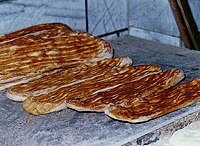Barbari bread
 | |
| Place of origin | Iran |
|---|---|
| Main ingredients | Flour |

Barbari bread (Persian: نان بربری) is a type of Persian flatbread primarily made in Iran. It is one of the thickest flat breads.[1]
Barbari means "of or related to Barbars" in Persian. Barbars are a group of people living in Khorasan near eastern borders of Iran. According to Dehkhoda Dictionary of Persian Language, this bread was baked by the Barbar (Hazara) people and was brought to Tehran, becoming popular during the Qajar period. In Iran, the Hazaras were known as Barbari ("barbarian," "foreign," "uncivilized"), which they resented. Reza Shah of Iran granted them the name of Khavari ("Easterners") through a decree, and since then, the name Barbari has been abandoned and no longer applies to the ethnic group. However, the bread is still referred to as Nan-e Barbari (bread made by the Barbarians) in Iran while Hazaras refer to it as Nan-e Tandoori (bread made in the Tandoor oven).[2]
The bread is usually between 70cm to 80cm long, and 25cm to 30cm wide.[3] It is the most common style baked in Iran. It is served in many restaurants with Lighvan cheese, of ewe's milk, similar to feta cheese.[4]
See also
- Naan
- Taftan, Iranian bread
- Sangak, an unleavened Iranian flatbread
- Lavash, an unleavened Armenian flatbread popular in Iran
References
- ^ Ram, Sewa (2009). Cereals: Processing and Nutritional Quality. New India Publishing. p. 27. ISBN 978-9-380-23507-3.
- ^ Hazara.net.
- ^ Qarooni, Jalal (2012). Flat Bread Technology. Springer Science & Business Media. p. 75. ISBN 978-1-461-31175-1.
- ^ "Persian Nan o Paneer (Bread with Cheese)". Reform Judaism. Retrieved 4 May 2015.

